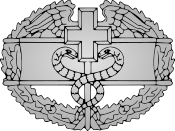Veterans of Foreign Wars
The Veterans of Foreign Wars (VFW), formally the Veterans of Foreign Wars of the United States, is an organization of U.S. war veterans, who, as military service members fought in wars, campaigns, and expeditions on foreign land, waters, or airspace.[5][7] The organization was established by James C. Putnam on 29 September 1899, in Columbus, Ohio and is headquartered in Kansas City, Missouri.[2][1]
 The VFW's logo since 2018 | |
Washington Memorial Building Washington, D.C., United States | |
| Abbreviation | VFW |
|---|---|
| Established | September 29, 1899[1] |
| Founder | James C. Putnam[2] |
| Founded at | Columbus, Ohio, U.S.[2] |
| Merger of | American Veterans of Foreign Service (organized on September 29, 1899, at Columbus, Ohio, U.S.) and the Army of the Philippines (organized on December 12, 1899, at Denver, Colorado, U.S., as the Colorado Society, Army of the Philippines)[3] |
| Type | 501(c)(19), war veterans' organization[4] |
| 44-0474290 | |
| Purpose | Fraternal, patriotic, historical, charitable, and educational[5] |
| Headquarters | 406 West 34th Street, Kansas City, Missouri, U.S. |
| Coordinates | 39.0668144°N 94.591009°W |
Area served | Worldwide |
Membership (2018) | 1,159,428 |
Official language | English[6] |
| Hal J. Roesch II (VA) Since July 24, 2020 | |
| None | |
| Matthew M. Mihelcic (IL) Since July 24, 2019 | |
National Council of Administration | 63 voting members
|
Main organ | VFW National Convention |
| Subsidiaries |
|
| Affiliations | Student Veterans of America |
Revenue (2015) | US$98,724,340[4] |
| Expenses (2015) | US$89,099,521[4] |
Employees (2014) | 224[4] |
Volunteers (2014) | 3,000[4] |
| Website | www |
Formerly called | Army of the Philippines, Cuba and Puerto Rico[3] |
History

The VFW resulted from the amalgamation of several societies formed immediately following the Spanish–American War. In 1899, little groups of veterans returning from campaigning in Cuba and the Philippine Islands, founded local societies upon a spirit of comradeship known only to those who faced the dangers of that war side by side. Similar experiences and a common language drew them together.[2] The American Veterans of Foreign Service (predecessor to the Veterans of Foreign Wars of the United States) was established in Columbus, Ohio, September 29, 1899, by Spanish‑American War veteran James C. Putnam.[8] The Colorado Society, Army of the Philippines, was organized in Denver, Colorado, on December 12, 1899. Shortly thereafter, a society known as the Foreign Service Veterans was born in Pennsylvania. These three veterans' organizations grew up side by side, increasing in scope and membership until August 1913, when at an encampment held at Denver, they merged their interests and identities in a national organization now known as the VFW.[2]
Purpose
The purpose of the VFW is to speed rehabilitation of the nation's disabled and needy veterans, assist veterans' widows and orphans and the dependents of needy or disabled veterans, and promote Americanism by means of education in patriotism and by constructive service to local communities. The organization maintains both its legislative service and central office of its national rehabilitation service in Washington. The latter nationwide program serves disabled veterans of all wars, members and nonmembers alike, in matters of government compensation and pension claims, hospitalization, civil-service employment preference, etc."[7]
Logo
Redesigned in November 2018, the official logo of the VFW includes an artistic representation of service stripes, easily recognizable insignia indicative of military service. Worn on most service uniforms, they denote length of service. As such, the first and leaner of the two service stripes represents the VFW's entry into its second century of service to America’s veterans, service members and their families. The second, broader stripe represents its first century of service, spanning back to 1899.
Great Seal
The Cross of Malta is the VFW's official emblem.[9] The cross, radiating rays, and Great Seal of the United States together symbolize the character, vows and purposes distinguishing VFW as an order of warriors who have traveled far from home to defend sacred principles. Its eight points represent the beatitudes prescribed in the Sermon on the Mount: Blessed are the poor in spirit, the meek, the pure, the merciful, the peacemakers; blessed are they who mourn, seek righteousness and are persecuted for righteousness' sake. The eight-pointed Cross of Malta harks back to the Crusades, launched during the 12th century.[10]
Eligibility
Membership in the VFW is restricted to any active or honorably discharged officer or enlisted person who is a citizen of the United States and who has served in its armed forces "in any foreign war, insurrection or expedition, which service shall be recognized by the authorization or the issuance of a United States military campaign medal."[7]
The following is a list of U.S. campaign medals, ribbons, and badges used by the Veterans of Foreign Wars of the United States to determine membership eligibility.[11]
| Eligibility guide | ||||||||||||||||||||||||||||||||||||||||||||||||||||||||||||||||||||||||||||||||||||||||||||||||||||||||||||||||||||||||||||||
|---|---|---|---|---|---|---|---|---|---|---|---|---|---|---|---|---|---|---|---|---|---|---|---|---|---|---|---|---|---|---|---|---|---|---|---|---|---|---|---|---|---|---|---|---|---|---|---|---|---|---|---|---|---|---|---|---|---|---|---|---|---|---|---|---|---|---|---|---|---|---|---|---|---|---|---|---|---|---|---|---|---|---|---|---|---|---|---|---|---|---|---|---|---|---|---|---|---|---|---|---|---|---|---|---|---|---|---|---|---|---|---|---|---|---|---|---|---|---|---|---|---|---|---|---|---|---|
| ||||||||||||||||||||||||||||||||||||||||||||||||||||||||||||||||||||||||||||||||||||||||||||||||||||||||||||||||||||||||||||||
Membership and structure
As of 2020 the VFW has 1.6 million members and Auxiliary members, forming 6,000 local chapters known as Posts, grouped into 52 Departments covering the 50 states, the Asia-Pacific area, and Europe.[12]
Support and Assistance Programs
The VFW offers a wide range of assistance programs aimed at helping veterans of every generation. Whether that means providing free, professional help filing or appealing a VA claim, offering scholarships for post-secondary education or providing emergency financial relief when times get tough, the VFW is there for America's veterans.
VA Claims and separation assistance
The VFW's National Veterans Service program consists of a nationwide network of VA accredited service officers and pre-discharge representatives who are experts in dealing with the VA and are the key to your success. Our cadre of highly-trained and professional advocates help veterans cut through bureaucratic red tape. VA reports veterans represented by the VFW have recoup $8.3 billion in earned benefits, including $1.4 billion in new claims in 2018 alone.[13]
Pre-Discharge
With offices located on or near major military installations across the country, VFW Pre-Discharge representatives guide military personnel through the veterans claims process and conduct physical examinations prior to their separation from active duty. They are also ready to answer questions about education and medical benefits, as well as VA home loans.[14]
Student Veteran Support
Help A Hero Scholarship
Established in 2014, the VFW's Help A Hero Scholarship provides service members and veterans with financial assistance they need to complete their educational goals without incurring excessive U.S. student loan debt.[15]
1 Student Veteran
To help ensure student veterans receive their benefits in a timely manner and have a place to turn to if they need help, the VFW, in conjunction with the Student Veterans of America (SVA), have developed the 1 Student Veteran program. 1 Student Veteran offers direct assistance to student veterans who have questions or are experiencing problems accessing their VA benefits.[15]
VFW-SVA Legislative Fellowship
The VFW-SVA Legislative Fellowship grants 10 exemplary student veterans (fellows) the chance to join the VFW legislative team on Capitol Hill during the VFW Legislative Conference in extremely late spring each year. The fellows will walk the halls of Congress, educating their legislators on the issues facing today’s student veterans and have the opportunity to meet with policy-makers from federal agencies responsible for implementing veterans' policy.[16]
Veterans and Military Support Programs
The VFW's Veterans & Military Support Programs is the umbrella for three successful, long-standing programs; Operation Uplink, Unmet Needs, and the Military Assistance Program (MAP). These initiatives focus on troop support.[17]
Military Assistance Program
MAP is the link between the VFW and the community. MAP is designed to promote VFW interaction within the local military community through the Adopt-A-Unit Program. MAP Grants are available to posts, districts, and departments who participate in a variety of morale boosting functions such as farewell and welcome home events.[17]
Operation Uplink
Operation Uplink keeps military members in contact with their loved ones by allowing deployed troops to call home at no charge from MWR internet cafés in Afghanistan, Kuwait and other locations all around the world. Operation Uplink also distributes "virtual pins" which enable wounded warriors and veterans in Veterans Affairs facilities to call from home at no cost.[17]
Unmet Needs
Unmet Needs assists military service members and their families who run into unexpected financial difficulties as a result of deployment or other hardships directly related to military service. Assistance is in the form of a grant of up to US$1,500. Unmet Needs assists with basic life needs such as: mortgage and rent, home and auto repairs, insurance, utilities, food and clothing.[17]
Programs
The VFW promotes civic responsibility, patriotism, and supports youth and local programs in communities across America.
Voice of Democracy

Each year, nearly 40,000 high school students from across the country enter to win a share of the US$2.1 million in educational scholarships and incentives awarded through the VFW's Voice of Democracy audio-essay competition.[18] The national first-place winner receives a $30,000 scholarship.
Patriot's Pen
Patriot's Pen challenges students from grades 6-8, to enter to win one of 46 national awards totaling US$55,000, as well as $5,000 and an all-expense-paid trip to Washington, D.C. for the national first-place winner. Students draft a 300-400 word essay, expressing their views based on a patriotic, annual theme chosen by the VFW Commander in Chief.[18]
Scout of the Year
Scout of the Year selects three young people – of the Boy or Girl Scouts, Sea Scouts or Venturing Crew – who have demonstrated practical citizenship in school, scouting and the community. The first-place winner receives a US$5,000 award, the second-place winner receives a US$3,000 award and the third-place winner receives US$1,000.[18]
Teacher of the Year
Teacher of the Year recognizes three exceptional teachers for their outstanding commitment to teach Americanism and patriotism to their students. The VFW recognizes the nation's top classroom elementary, junior high and high school teachers who teach citizenship education topics – at least half of the school day in a classroom environment – and promote America's history, traditions and institutions effectively.[18]
Community Service
The VFW host events across America, as well as giving grants and helping at large-scale volunteer events. [18]
Publications
The VFW also publishes the monthly VFW Magazine. It was known as Foreign Service before 1951.
Notable members
Notable members of the Veterans of Foreign Wars of the United States have included:[19][20]
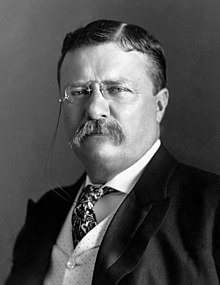 Theodore Roosevelt, 26th President of the United States
Theodore Roosevelt, 26th President of the United States.jpg) Harry Truman, 33rd President of the United States
Harry Truman, 33rd President of the United States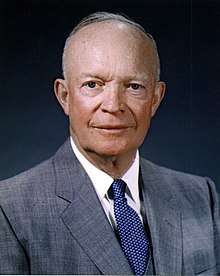 Dwight Eisenhower, 34th President of the United States
Dwight Eisenhower, 34th President of the United States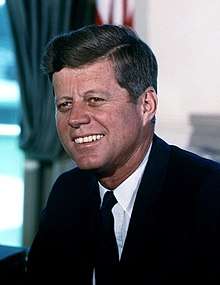 John Kennedy, 35th President of the United States
John Kennedy, 35th President of the United States Lyndon Johnson, 36th President of the United States
Lyndon Johnson, 36th President of the United States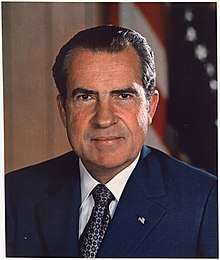 Richard Nixon, 37th President of the United States
Richard Nixon, 37th President of the United States.jpg) Gerald Ford, 38th President of the United States
Gerald Ford, 38th President of the United States.jpg) George Bush, 41st President of the United States
George Bush, 41st President of the United States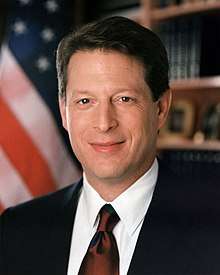 Albert Gore Jr., 45th Vice President of the United States
Albert Gore Jr., 45th Vice President of the United States Robert Kennedy, United States Senator from New York
Robert Kennedy, United States Senator from New York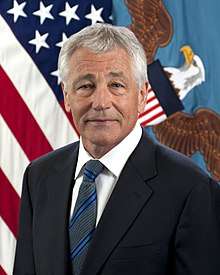 Chuck Hagel, 24th United States Secretary of Defense
Chuck Hagel, 24th United States Secretary of Defense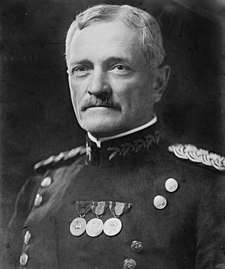 General John Pershing, 10th Chief of Staff of the United States Army
General John Pershing, 10th Chief of Staff of the United States Army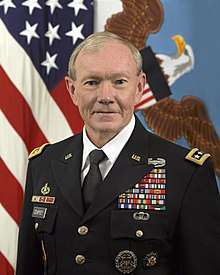 General Martin Dempsey, 18th Chairman of the Joint Chiefs of Staff
General Martin Dempsey, 18th Chairman of the Joint Chiefs of Staff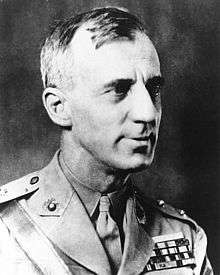 Major General Smedley Butler, two-time Medal-of-Honor recipient
Major General Smedley Butler, two-time Medal-of-Honor recipient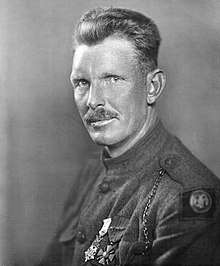 Sergeant Alvin York, Medal-of-Honor recipient
Sergeant Alvin York, Medal-of-Honor recipient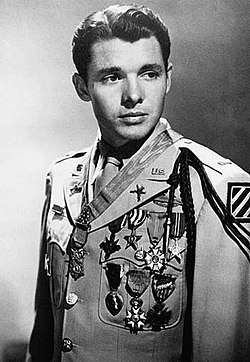 First Lieutenant Audie Murphy, Medal-of-Honor recipient
First Lieutenant Audie Murphy, Medal-of-Honor recipient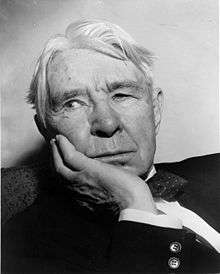 Carl Sandburg, three-time Pulitzer-Prize winner
Carl Sandburg, three-time Pulitzer-Prize winner Roger Staubach, Pro Football Hall of Fame inductee
Roger Staubach, Pro Football Hall of Fame inductee
See also
- List of veterans organizations
References
- Mason Jr., Herbert Molloy (1999). VFW: Our First Century. Foreword by Senator Chuck Hagel. Lenexa, Kansas: Veterans of Foreign Wars of the United States. pp. 29, 39, 92. ISBN 1-88611072-7. LCCN 99-24943. OCLC 777720483 – via Addax Publishing Group.
- Proceedings of the 34th National Encampment of the Veterans of Foreign Wars of the United States (Report). Milwaukee, Wisconsin: Wisconsin Veteran. 1933. pp. 5, 31 – via Internet Archive.

- Mason Jr., Herbert Molloy (1999). VFW: Our First Century. Foreword by Senator Chuck Hagel. Lenexa, Kansas: Veterans of Foreign Wars of the United States. p. 225. ISBN 1-88611072-7. LCCN 99-24943. OCLC 777720483 – via Addax Publishing Group.
- "Form 990: Return of Organization Exempt from Income Tax." Veterans of Foreign Wars of the United States. Guidestar. August 31, 2015.
- Veterans of Foreign Wars of the United States Congressional Charter, National By-Laws, Manual of Procedure and Ritual (2018 Podium ed.). Kansas City, Missouri: Veterans of Foreign Wars of the United States. 2017. p. 7.
- Veterans of Foreign Wars of the United States Congressional Charter, National By-Laws, Manual of Procedure and Ritual (2018 Podium ed.). Kansas City, Missouri: Veterans of Foreign Wars of the United States. 2017. p. 42.
- "Veterans of Foreign Wars (VFW)". Encyclopædia Britannica. 2015. Retrieved November 14, 2016.
- Mason Jr., Herbert Molloy (1999). VFW: Our First Century. Foreword by Senator Chuck Hagel. Lenexa, Kansas: Veterans of Foreign Wars of the United States. pp. 29, 38–40. ISBN 1-88611072-7. LCCN 99-24943. OCLC 777720483 – via Addax Publishing Group.
- Veterans of Foreign Wars of the United States Congressional Charter, National By-Laws, Manual of Procedure and Ritual (2018 Podium ed.). Kansas City, Missouri: Veterans of Foreign Wars of the United States. 2017. p. 44.
- Mason Jr., Herbert Molloy (1999). VFW: Our First Century. Foreword by Senator Chuck Hagel. Lenexa, Kansas: Veterans of Foreign Wars of the United States. p. 15. ISBN 1-88611072-7. LCCN 99-24943. OCLC 777720483 – via Addax Publishing Group.
- Veterans of Foreign Wars of the United States Congressional Charter, National By-Laws, Manual of Procedure and Ritual (2018 Podium ed.). Kansas City, Missouri: Veterans of Foreign Wars of the United States. 2017. pp. 56–61.
- "VFW at a Glance" (PDF). VFW. Retrieved February 24, 2020.
- "VA Claims & Separation Benefits". www.vfw.org. Retrieved November 16, 2018.
- "VA Claims & Separation Benefits". www.vfw.org. Retrieved November 16, 2018.
- "Student Veteran Support". www.vfw.org. Retrieved November 16, 2018.
- "Student Fellowship". www.vfw.org. Retrieved November 16, 2018.
- "National Military Services". Recruiter Success Pocket Guide [Brochure]. Kansas City, MO: Veterans of Foreign Wars. January 2014.
- "Programs". Recruiter Success Pocket Guide [Brochure]. Kansas City, MO: Veterans of Foreign Wars. January 2014.
- Mason Jr., Herbert Molloy (1999). VFW: Our First Century. Foreword by Senator Chuck Hagel. Lenexa, Kansas: Veterans of Foreign Wars of the United States. pp. 9, 16, 47, 90–91, 118, 104, 132, 204. ISBN 1-88611072-7. LCCN 99-24943. OCLC 777720483 – via Addax Publishing Group.
- Ford, Gerald R. (1979). A Time To Heal: The Autobiography of Gerald R. Ford (1st ed.). New York: Harper & Row. p. 62. ISBN 0-06-011297-2. LCCN 78020162. OCLC 4835213. OL 4731652M.
Further reading
- Bottoms, Bill (1991). The VFW: An Illustrated History of the Veterans of Foreign Wars of the United States. Foreword by Senator Bob Dole. Rockville, Md.: Woodbine House. ISBN 0933149344. LCCN 89040627. OCLC 22593204. OL 8387800M.
- Proceedings of the 99th National Convention of the Veterans of Foreign Wars of the United States [Summary of Minutes] (Report). Washington: GPO. 2000 – via Internet Archive.
- Proceedings of the 100th Annual Convention of the Veterans of Foreign Wars of the United States [Summary of Minutes] (Report). Washington: GPO. 2000 – via Internet Archive.
- White, Dean A., ed. (1999). Watch on the Rhein: A History. Wiesbaden, Germany: Watch on the Rhein Post 27, Veterans of Foreign Wars of the United States.
External links
- Official
- General information
- Proceedings of the Annual Convention of the Veterans of Foreign Wars of the United States at The Online Books Page
- United States of America Vietnam War Commemoration at the Department of Defense Vietnam War Commemoration Program Office
- Veterans of Foreign Wars at the Encyclopædia Britannica
- VFW National Home for Children in Eaton Rapids, Michigan
- Veterans of Foreign Wars politician members at The Political Graveyard
- Works by or about Veterans of Foreign Wars at Internet Archive
- Works by or about Veterans of Foreign Wars in libraries (WorldCat catalog)
